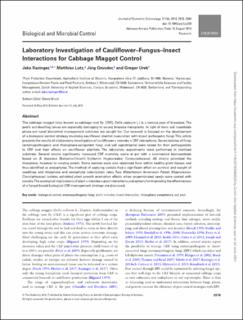Please use this identifier to cite or link to this item:
https://doi.org/10.21256/zhaw-16367Full metadata record
| DC Field | Value | Language |
|---|---|---|
| dc.contributor.author | Razinger, Jaka | - |
| dc.contributor.author | Lutz, Matthias | - |
| dc.contributor.author | Grunder, Jürg | - |
| dc.contributor.author | Urek, Gregor | - |
| dc.date.accessioned | 2019-03-28T13:16:38Z | - |
| dc.date.available | 2019-03-28T13:16:38Z | - |
| dc.date.issued | 2018 | - |
| dc.identifier.issn | 0022-0493 | de_CH |
| dc.identifier.issn | 1938-291X | de_CH |
| dc.identifier.uri | https://digitalcollection.zhaw.ch/handle/11475/16367 | - |
| dc.description | Erworben im Rahmen der Schweizer Nationallizenzen (http://www.nationallizenzen.ch) | de_CH |
| dc.description.abstract | The cabbage maggot (also known as cabbage root fly [CRF]; Delia radicum L.) is a serious pest of brassicas. The pest's soil-dwelling larvae are especially damaging to young brassica transplants. In light of toxic soil insecticide phase-out novel biocontrol management solutions are sought for. Our research is focused on the development of a biological control strategy involving cauliflower plantlet inoculation with insect pathogenic fungi. This article presents the results of a laboratory investigation of cauliflower × microbe × CRF interactions. Seven isolates of fungi (entomopathogenic and rhizosphere-competent fungi and soil saprotrophs) were tested for their pathogenicity to CRF and their effects on cauliflower plantlets. The laboratory experiments were performed in sterilized substrate. Several strains significantly increased CRF mortality, some at par with a commercial bioinsecticide based on B. bassiana (Balsamo-Crivelli) Vuillemin (Hypocreales: Cordycipitaceae). All strains colonized the rhizoplane, however to varying extent. Some isolates were also reisolated from within healthy plant tissues and thus identified as endophytes. The method of applying conidia had a significant effect on survival and weight of seedlings and rhizoplane and endophytic colonization rates. Two Metarhizium brunneum Petsch (Hypocreales: Clavicipitaceae) isolates exhibited plant growth promotion effects when ungerminated seeds were coated with conidia. The ecological implications of plant × microbe × pest interactions and options for improving the effectiveness of a fungal-based biological CRF management strategy are discussed. | de_CH |
| dc.language.iso | en | de_CH |
| dc.publisher | Oxford University Press | de_CH |
| dc.relation.ispartof | Journal of Economic Entomology | de_CH |
| dc.rights | Licence according to publishing contract | de_CH |
| dc.subject | Biological control | de_CH |
| dc.subject | Entomopathogenic fungi | de_CH |
| dc.subject | Plant–microbe–insect interaction | de_CH |
| dc.subject | Rhizosphere competence | de_CH |
| dc.subject | Soil pest | de_CH |
| dc.subject.ddc | 630: Landwirtschaft | de_CH |
| dc.title | Laboratory investigation of cauliflower–fungus–insect interactions for cabbage Maggot control | de_CH |
| dc.type | Beitrag in wissenschaftlicher Zeitschrift | de_CH |
| dcterms.type | Text | de_CH |
| zhaw.departement | Life Sciences und Facility Management | de_CH |
| zhaw.organisationalunit | Institut für Umwelt und Natürliche Ressourcen (IUNR) | de_CH |
| dc.identifier.doi | 10.1093/jee/toy228 | de_CH |
| dc.identifier.doi | 10.21256/zhaw-16367 | - |
| dc.identifier.pmid | 30107578 | de_CH |
| zhaw.funding.eu | No | de_CH |
| zhaw.issue | 6 | de_CH |
| zhaw.originated.zhaw | Yes | de_CH |
| zhaw.pages.end | 2584 | de_CH |
| zhaw.pages.start | 2578 | de_CH |
| zhaw.publication.status | publishedVersion | de_CH |
| zhaw.volume | 111 | de_CH |
| zhaw.embargo.end | 2022-01-01 | de_CH |
| zhaw.publication.review | Peer review (Publikation) | de_CH |
| Appears in collections: | Publikationen Life Sciences und Facility Management | |
Files in This Item:
| File | Description | Size | Format | |
|---|---|---|---|---|
| 2018_Razinger-etal_Laboratory-investigation-of-cauliflower-fungus-insect-interactions.pdf | 1.01 MB | Adobe PDF |  View/Open |
Show simple item record
Razinger, J., Lutz, M., Grunder, J., & Urek, G. (2018). Laboratory investigation of cauliflower–fungus–insect interactions for cabbage Maggot control. Journal of Economic Entomology, 111(6), 2578–2584. https://doi.org/10.1093/jee/toy228
Razinger, J. et al. (2018) ‘Laboratory investigation of cauliflower–fungus–insect interactions for cabbage Maggot control’, Journal of Economic Entomology, 111(6), pp. 2578–2584. Available at: https://doi.org/10.1093/jee/toy228.
J. Razinger, M. Lutz, J. Grunder, and G. Urek, “Laboratory investigation of cauliflower–fungus–insect interactions for cabbage Maggot control,” Journal of Economic Entomology, vol. 111, no. 6, pp. 2578–2584, 2018, doi: 10.1093/jee/toy228.
RAZINGER, Jaka, Matthias LUTZ, Jürg GRUNDER und Gregor UREK, 2018. Laboratory investigation of cauliflower–fungus–insect interactions for cabbage Maggot control. Journal of Economic Entomology. 2018. Bd. 111, Nr. 6, S. 2578–2584. DOI 10.1093/jee/toy228
Razinger, Jaka, Matthias Lutz, Jürg Grunder, and Gregor Urek. 2018. “Laboratory Investigation of Cauliflower–Fungus–Insect Interactions for Cabbage Maggot Control.” Journal of Economic Entomology 111 (6): 2578–84. https://doi.org/10.1093/jee/toy228.
Razinger, Jaka, et al. “Laboratory Investigation of Cauliflower–Fungus–Insect Interactions for Cabbage Maggot Control.” Journal of Economic Entomology, vol. 111, no. 6, 2018, pp. 2578–84, https://doi.org/10.1093/jee/toy228.
Items in DSpace are protected by copyright, with all rights reserved, unless otherwise indicated.